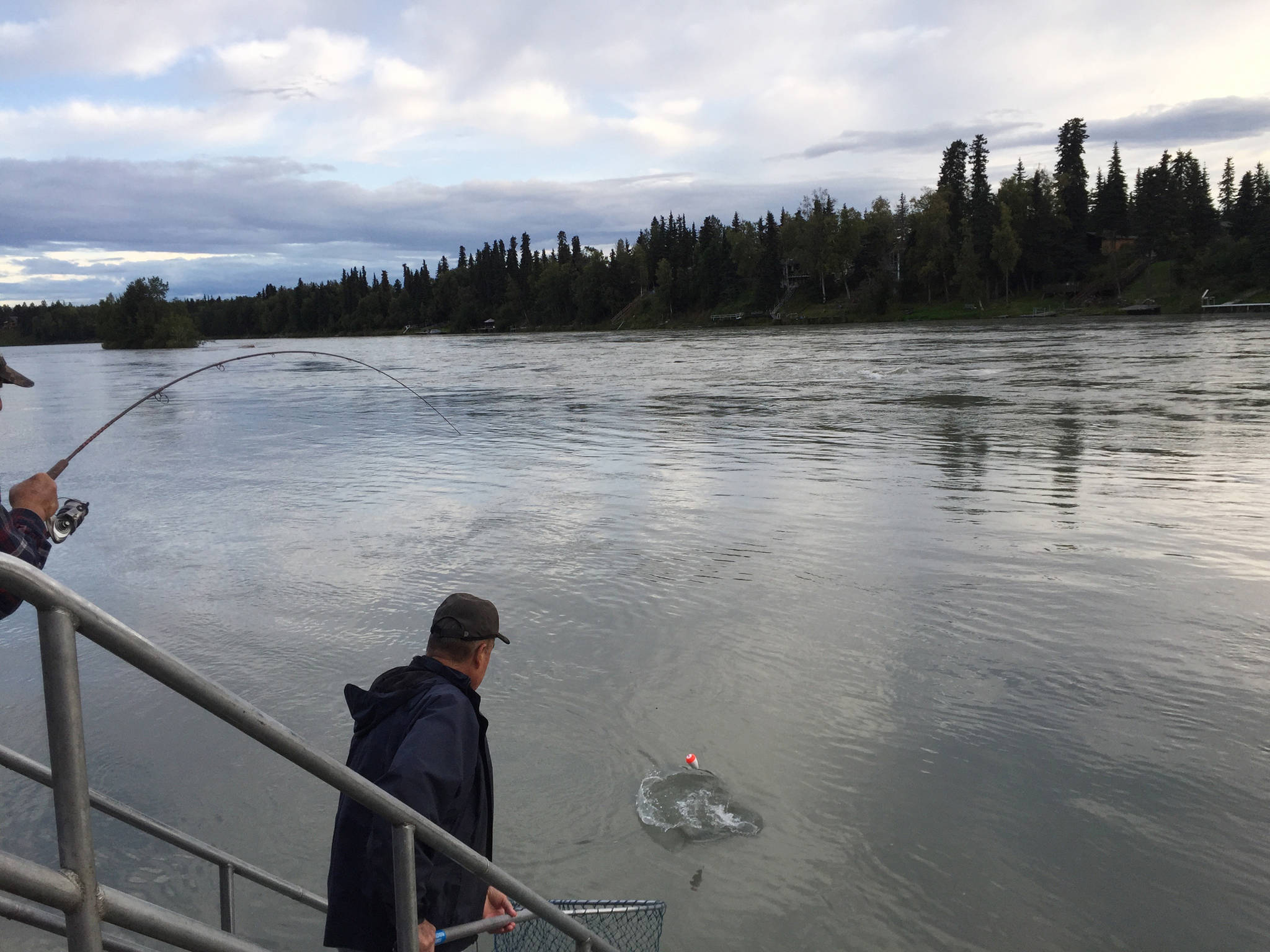A draft morning schedule for a silver salmon angler:
4 a.m.: Alarm goes off. Pat self on back for packing tackle the evening before.
4:30 a.m.: Start car. Early fall temperatures in Alaska in August can be in the 40s before the sun comes up, and last one to the fishing dock is the loser.
5 a.m.: Roll up to the fishing docks, sometimes at Bing’s Landing in Sterling, sometimes at Centennial Park in Soldotna, depending on the day. Unload gear and queue up with the dozen or more other early-morning anglers that know the habits of silver salmon.
5:15 a.m.: Rig up pole. Peek at other anglers’ setups and shake head, because no one agrees about what the best tackle to fish for silvers is.
5:30 a.m.: Toss first cast out, and wait. Reconsider water movement patterns, dismiss the reconsideration, reconsider the reconsideration.
So the morning goes for a lot of silver salmon fishermen on the Kenai River. By 8 a.m. Wednesday, the fishing platform below the Soldotna Visitors Center just downstream of the David E. Douthit Veterans Memorial Bridge was a thinner crowd than at 5 a.m., though a few were still walking away with their fish for the morning. The anglers left kept up a rotation of casting, walking their poles downstream, reeling in, and walking back up the boardwalk to cast again.
Silver salmon, also known as coho, often hit hard early in the morning when the water temperatures are cool, and again in the evening. The silvers that the anglers were taking home from Soldotna on Wednesday morning were still bright, some with hefty girths pushing up their weights.
However, the water quality took a dive in the early part of the week due to the rain and the Killey River pushing mud into the Kenai River, clouding up the water and dampening fishing conditions.
“Yesterday we limited out,” said Dave Goggia, owner and guide at Hooky Charters. “We did pretty good (Wednesday) morning until the water got dirty and then they just quit biting.”
Goggia said the silver salmon fishing has been relatively good so far, with anglers catching limits in his boats, depending on the day. Success depends on where anglers are in the river — for the last several days, guides have been down in the lower river in locations like Eagle Rock, near the state boat launch, he said.
However, many may now be headed upstream with the water muddy, said Jason Pawluk, the assistant area management biologist for the Division of Sportfish in Soldotna.
“When conditions get like this, the best place to go fishing is between Skilak (Lake) and above the Killey,” he said. “…That’s where everybody’s headed. It’s good that there’s bait in the water for coho, because that can really help.”
Logbook data from the guides, which isn’t a formal measure but gives an idea of how the guides are doing, shows that silver fishing has kept up for the last few weeks: many people are still getting limits, Pawluk said. There’s no saying exactly what the abundance of silvers on the river is, but fishermen both in the commercial fisheries and in the sport fisheries have been seeing a lot of them this year.
That’s hopeful for good fishing throughout September, said Jimmie Jack Drath, owner of Jimmie Jack’s Alaska Fishing Lodges in Kenai.
“The silvers are really nice on the Kenai River right now,” he said. “It’s been pretty consistent. I think the water is getting a little muddy right now, so I think we might have a couple of days (of slower fishing) … But there’s plenty of fish in there.”
The bag limit for silvers longer than 16 inches on the Kenai River drainage other than on the Russian River and in the Russian River confluence area also increases from two to three fish per day with six in possession effective Friday. The bag limit for silvers smaller than 16 inches is 10 per day with 10 in possession, by regulation.
However, up on the section of the Kenai River upstream of the Killey River to Skilak Lake, anglers also don’t get to use bait or multiple hooks after Sept. 1. Regulation requires that anglers use only unbaited, single-hook artificial lures in that area between Sept. 1 and Dec. 31. Some anglers will likely continue fishing that area, especially if water conditions stay muddy downstream of the Killey River, but their gear restrictions will make angling less efficient, Pawluk said.
Moving forward into the fall, with sockeye salmon spawned out and kings gone, the fishing is all about the silvers and resident species.
“This is some of the best fishing of the year the river has to offer,” Pawluk said. “Coho fishing is going to be excellent whenever the water conditions are good and probably will be through October. We’re just hitting the peak of (resident species fishing) with the sockeye spawning.”
On a foot survey up the Russian River on Wednesday, Pawluk said Fish and Game staff saw coho moving into the river system alongside the sockeye. Sockeye fishing on the Russian River is closed for the season as of Aug. 21, but anglers can still target coho, trout and Dolly Varden in the river, which is a clear, snow-fed river as opposed to the teal, glacial Kenai River.
On Wednesday, the anglers targeting trout and Dolly Varden on the Russian were doing well with beads designed to resemble sockeye salmon eggs, Pawluk said.
Drath said though Jimmie Jack does some trout fishing, clients usually prefer silver salmon fishing in the fall. However, the rainbows have been biting on the lower river as well, he said.
Goggia said his trips for trout have been having good luck as well recently.
“The sockeye are starting to put some eggs out, and that definitely helps,” he said.
Reach Elizabeth Earl at elizabeth.earl@peninsulaclarion.com.

